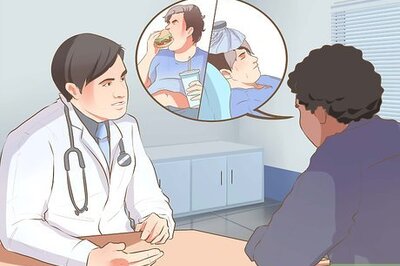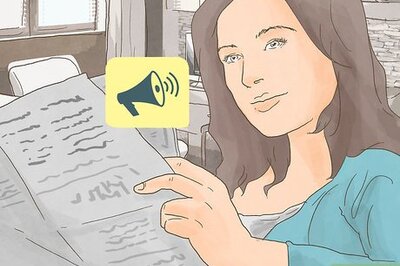
views
With the release of the 2020 National Crime Records Bureau (NCRB) report on suicides, the question that comes to the fore is why does the data come under the ministry of home affairs. As Section 309 of India Penal Code decriminalised and Mental Health Care Act removed it from the ambit of offence, these statistics should be released by the Ministry of Health and Family welfare, according to associate professor Dr Devavrat Harshe from Kolhapur. He is right as the stigma and shame will be then minimised. Also, it would be better if the data for rural and urban sectors are separately provided in the future.
As the suicide rates have increased by 10% in 2020, to 1,53,052 from 1,39,123 in 2019, the crime rates also increased by 28% this year to 51,56,158 in 2019 to 66,01,285 in 2020. There is something happening in the underbelly of our country.
Covid-19 is the primary cause that has disrupted the fragile psycho-social ecosystem of people already traumatised by rapid social change, financial issues, an evolving social justice system and poverty.
Malnutrition, stunting, wasting and anemia have increased in children in several states across the country, according to the National Family Health Survey. These have mental health implications for suicide too.
Death by suicide is actually an ‘Accident of the Mind’. Health minister Mansukh Mandaviya and the government have their hands full as family problems being the major cause of death by suicide has increased from 30.4% in 2018 to 32.4% in 2019 to 33.6% in 2020.
Another factor being spousal violence that has increased in five states — Sikkim, Maharashtra, Himachal Pradesh, Assam and Karnataka, according to the survey. Except Assam, all other states have a higher suicide rate than the national average. The National Commission for Women also reported a two-fold rise in domestic violence complaints during the initial phase of the lockdown in 2020.
Whether this has contributed to the rise in family issues is something that needs to be investigated.
Three of the top five states with most suicides – Maharashtra, Tamil Nadu, West Bengal, Madhya Pradesh and Karnataka – were among the top GDP contributors for 2020.
So, the common factor that emerges is that family mental health interventions mostly among the poor, less educated, and married men and women are a must.
ALSO READ | What Parents Must Watch Out for: COVID Symptoms & Pandemic Effect on Kids’ Mental Health
What the Numbers Say
The data shows that 96,810 of the 1,53,052 who died of suicide had an income of less than Rs 1 lakh a year.
Moreover, 95.5% of those who died of self-harm had an income less than Rs 5 lakh a year. Nearly 46,057 of the 1,085,32 men who died of self-harm were daily wage labourers and unemployed.
Of the 44,498 women who died, 22,372 were housewives. Around 73,093 married men also chose to end their lives. About 51.6 % of people have died due to family problems and illness. Around 96% who committed suicide were illiterate and did their post matric.
Another trend that has come to the fore is around 27 suicides in 2020 took place on the railway tracks in Mumbai, according to the government railway police. This year, 42 deaths have been reported between January and September.
Focus on Mental Health of Women
Family problems, financial issues, relationships and marital problems and depression have been the causes of worsening mental health of women. Speculative research reveals that sudden increase in real estate prices in Metros too have caused an increase in mental health issues as families could not afford homes for their children.
The Ministry of Women and Child Development has at least 15 programmes, including ‘Beti Bachao, Beti Padao’ and ‘Swadhar Greh’ (women who are without any social or economic support), which among other things should also have medical-social workers and mental health professionals reach out to women.
ALSO READ | Sexist Expectations, Social Stigma: Why Decent Mental Healthcare Remains Beyond Indian Woman’s Reach
Reaching Out to Marginalised
More attention needs to be provided to the marginalised section of the society. The government in a massive effort has reached out to the poor with a lot of financial initiatives. Students studying mental health science need to be galvanised and earmarked for this process.
Around 30% of the time in any Masters course in Psychology, Medical Social Work or Psychiatry should be used for community outreach programmes. This will provide learnings for the students about issues such as the socio-economic and cultural dynamics that affect the poor. District mental health programmes should have a strong outreach arm. Breaking the stigma needs intervention at the doorstep.
Need an Army of Mental Health Personnel
At present, India has 9,000 psychiatrists, 2,000 psychiatric nurses, 1,000 clinical psychologists and 1,000 psychiatric social workers. The country would need an additional 30,000 psychiatrists, 37,000 psychiatric nurses, 38,000 psychiatric social workers and 38,000 clinical psychologists. We have 0.75 psychiatrists for the 100,000 lakh population. We need at least 3 psychiatrists for 100,000 people.
Around 20 IIMs, 23 IITs and 22 AIIMS have been planned in India in the immediate future. The number of these premier educational institutions has grown exponentially in the last few years. Focusing on building mental health infrastructure is also a need of the hour.
Rural India faces a huge scarcity of mental health professionals (MHPs). We need more colleges and universities to churn out psychologists, medical social workers, occupational therapists, speech therapists, psychiatrists and others. Yet one needs to understand that ‘mental health is too important to be left to mental health professionals alone’. This needs political will similar to what we see today in building our military infrastructure and fighting Covid-19.
A top heavy system run by PhDs or MDs across the hierarchy is not the answer to run a campaign for bringing down the numbers of suicides in India. We need a pyramid with lakhs of ‘mental health soldiers’.
Mental health soldiers can be trained across five areas. It is important to identify distress and disorders, skills to provide emotional first aid, help individuals access treatment facilities, create mental health awareness among the community and also manage acute mental health crisis before a professional can intervene. Asha workers, Anganwadi members, health workers, teachers and anyone interested in helping others can be trained.
ALSO READ | Lack of Professionals, Social Stigma: India Has Miles to Go in Establishing Mental Health Infrastructure
Suicide Prevention Policy is a Must
India does not have a ‘Suicide Prevention Policy’. Dr Lakshmi Vijayakumar, who founded the mental health helpline ‘Sneha’ in Chennai, said, “Suicide prevention is not solely or even primarily the domain of mental health practitioners providing interventions for suicidal individuals. While not losing sight of the substantially heightened suicide risk for people with mental disorders, suicide is a complex and highly stigmatised issue in India, as it is elsewhere.”
Suicide prevention planning should be grounded in a broader public health approach framed around multi-sectoral collaboration and equal acknowledgement of the socio-economic and cultural determinants of suicide and suicide prevention in India.
Mental health is about feelings. As we calm down, we need to reach out to our mind, heart and soul. This is what we all need.
The author is known for his extensive work on suicide prevention. The views expressed in this article are those of the author and do not represent the stand of this publication.
Read all the Latest Opinions here




















Comments
0 comment